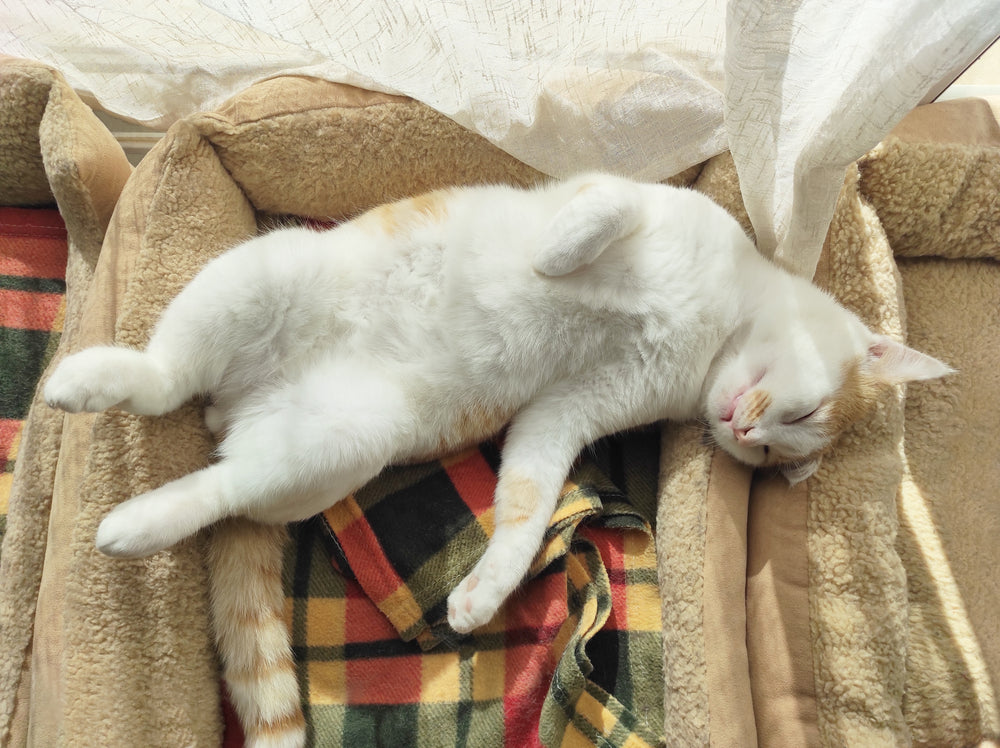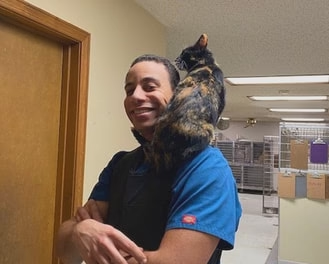8 Min Read
Hyperthyroidism In Cats (Overactive Thyroid In Felines)
Key takeaway

Why pet owners are switching to online vet care with Dutch
-
Prescriptions delivered free to you
-
Fast access to Licensed Vets over video
-
Unlimited video visits and follow-ups
The thyroid gland plays an essential role in controlling the hormones that affect the metabolism in both humans and cats. This gland helps ensure your cat’s metabolism is breaking down energy from food frequently enough to maintain all bodily functions. When the hormones that affect a cat’s metabolism are off, food isn’t being properly transferred to energy.
Just like humans, cats can suffer from an overactive thyroid or an underactive thyroid, with each condition leading to different medical issues. You might notice an increase in appetite in your cat or behavioral changes such as restlessness and aggression. These symptoms are a result of an overactive thyroid.
While there are feline hyperthyroid treatment options, it starts with diagnosing your cat. A vet can tell you whether your cat is suffering from hyperthyroidism or whether their symptoms might be caused by something else. To learn more about hyperthyroidism in cats, what the symptoms are, and how it’s treated, keep reading.
- What Is Hyperthyroidism in Cats?
- Symptoms of Hyperthyroidism in Cats
- Diagnosis and Treatment for Hyperthyroidism in Cats
- Hyperthyroidism in Cats: Frequently Asked Questions
What Is Hyperthyroidism In Cats?
Hyperthyroidism is a medical condition where the thyroid gland produces too much of a hormone called thyroxine, which plays an important role in the digestive system. This hormone essentially works like the speed control for your cat’s metabolism, letting their body know how quickly (or slowly) to break down food into energy that can be used throughout the body.
While most people consider hyperthyroidism a metabolism-related disease, there are several bodily functions that are affected by hyperthyroidism. This is why the symptoms that accompany hyperthyroidism range from things like increased thirst and urination to aggression, difficulty breathing, and depression. In some cases, diarrhea may also result from hyperthyroidism.
Because hyperthyroidism is a hormone-related disease that affects how much energy is created for the body, the symptoms may seem similar to other conditions. The best thing you can do is take your cat to a vet to get tested, so you can figure out what’s going on.

What makes a cat prone to Hyperthyroidism?
Despite being a fairly common disease in cats, it’s hard to pin down what leads to hyperthyroidism in cats. While there have been some suspected causes, there’s no concrete evidence that cats who meet certain criteria are more likely to suffer from hyperthyroidism.
As far as breed goes, there’s no evidence that a cat’s breed has anything to do with hyperthyroidism. Cats of all breeds can experience hyperthyroidism, and the numbers are similar across most breeds as far as experts can tell. However, there are certain breeds that seem to have a lower chance of hyperthyroidism, including Siamese, Burmese, Persian, Abyssinian, and Himalayan cats.
The one thing that seems to be a fairly common factor when it comes to hyperthyroidism in cats is age. Most cats who experience hyperthyroidism are on the older side, with the average age of cats who have hyperthyroidism being 12. On top of that, only about 5% of cats with hyperthyroidism are younger than 10 years old.
Symptoms Of Hyperthyroidism In Cats
When it comes to cat skin allergies, it’s usually not hard to spot a problem. However, hyperthyroidism may come with a wide range of symptoms, so it can be tough to figure out if your cat has hyperthyroidism or something else. Just remember, you should always visit a vet if you’re not sure what’s wrong with your cat.
Several hyperthyroidism symptoms in cats are easy to spot. If your cat is eating more but losing weight, that’s a sign of hyperthyroidism. You may also notice that your cat is drinking more and urinating more. And of course, vomiting and diarrhea may occur as a result of your cat’s overactive metabolism.

Here’s a complete list of symptoms you might notice when it comes to hyperthyroidism in cats:
- Weight loss despite an increased appetite
- Increased thirst
- Increased urination
- Increased heart rate
- Vomiting
- Diarrhea
- Restlessness/hyperactivity
- Aggressive behavior
- Difficulty breathing
- Weakness
- Mood changes/depression
-
Greasy or matted hair
Diagnosis And Treatment For Hyperthyroidism In Cats
Only your vet can properly examine and diagnose your cat with an overactive thyroid
To determine a diagnosis, your vet may:
Perform a physical exam to check your cat’s neck for an enlarged thyroid gland
The thyroid gland is located in the neck, which means your vet can perform a physical exam to see if there’s anything obviously wrong with your cat’s thyroid. An enlarged thyroid gland can be a sign of a goiter, which doesn’t necessarily mean your cat has a thyroid problem. However, checking the size of your cat’s thyroid is a good way to gauge its function, so this is a common first step for vets.
Take a blood chemistry panel to observe thyroid hormone levels
While anear infection may be diagnosed with physical tests, hyperthyroidism can be diagnosed using a blood chemistry panel. Your vet will run tests on your cat’s blood to determine thyroid hormone levels. This makes it easy to spot an overabundance or a lack of hormones that could be the cause of an irregular metabolism.
Urine test
Blood tests can be a great way to detect hyperthyroidism in cats, but they aren’t always accurate. Urine tests can help your vet detect more minor cases of hyperthyroidism that might go undetected in a blood test.
Heart ultrasounds
Ultrasounds can be another good way to test for hyperthyroidism in cats because this condition often affects heart health. A rapid heart rate may be a sign of hyperthyroidism, which gives vets a starting point to work with.

Treatment Options
Hyperthyroidism in cats can lead to all sorts of medical issues, but there are treatment options. Just like an itchy cat can be cured with skin care and avoiding allergenic foods, hyperthyroidism can be treated with the following treatment options:
- Medication
- Methimazole
- Surgery
- Diet changes
- Radioactive iodine
Methimazole is a common hyperthyroid medication in cats . This medication blocks the production of thyroid hormones to help slow down your cat’s metabolism. If that medication doesn’t work, your doctor may recommend surgery or radioactive iodine.
Hyperthyroidism In Cats: Frequently Asked Questions
How long does a cat live with hyperthyroidism?
While hyperthyroidism affects your cat’s metabolism, it also changes the way the rest of your cat’s body works. The physical changes caused by an overactive metabolism can lead to heart and kidney failure, which is why most cats who receive treatment for hyperthyroidism only live about 3 to 5 years. However, advancements in treatment for hyperthyroidism in cats mean you can make those 3 to 5 years enjoyable for your cat.

Do cats with hyperthyroidism suffer?
Left untreated, hyperthyroidism will cause several issues that affect a cat’s quality of life. Cats who experience hyperthyroidism may also experience vomiting and diarrhea, which are unpleasant side effects of this condition. Your cat may also lose weight despite eating more, and its hair may be matted and greasy as a result of a hyperactive metabolism.
With proper treatment, you can minimize this suffering and give your cat years of quality living with hyperthyroidism.
What are the symptoms of hyperthyroidism in cats?
If your cat is experiencing hyperthyroidism, you might notice them drinking more water and urinating more. You may also notice your cat losing weight even though they seem to have an increased appetite, and they may experience vomiting and diarrhea. Greasy, matted hair is another sign that your cat has an overactive thyroid gland.
How serious is hyperthyroidism in cats?
Hyperthyroidism in cats may be common, but it’s a serious condition. If your cat has hyperthyroidism, seeking treatment as soon as possible will help you minimize their symptoms and provide them with a happier life. Left untreated, hyperthyroidism can be fatal to cats, so you should always consult a vet if you notice symptoms of hyperthyroidism.
Final Notes
Taking care of your cat is important, especially if your cat has a chronic condition such as hyperthyroidism. As long as you get your cat treatment as soon as possible, they can still live a long, happy life for the next several years, even with hyperthyroidism.
If you think your cat may be experiencing hyperthyroidism, please contact your veterinarian as soon as possible.
Share
References
-
Hyperthyroidism in Cats, Cornell University College of Veterinary medicine, https://www.vet.cornell.edu/departments-centers-and-institutes/cornell-feline-health-center/health-information/feline-health-topics/hyperthyroidism-cats
-
Hyperthyroidism in Cats, VCA Hospitals, https://vcahospitals.com/know-your-pet/hyperthyroidism-in-cats
-
Levothyroxine, NHS,
https://www.nhs.uk/medicines/levothyroxine/

